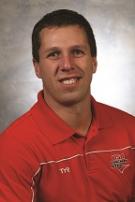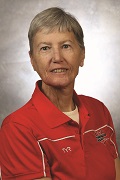

Clydesdale and Athena National Championships
The Clydesdale and Athena competitive divisions are based on weight minimums outlined in the USA Triathlon Competitive Rules. Athletes competing in the Clydesdale division must be a minimum of 220 pounds and athletes in the Athena division must be a minimum of 165 pounds. The first-ever standalone championships were held in 2014.
USA Triathlon began offering these divisions in response to the fact that we have a very active Clydesdale and Athena community who compete all around the U.S. in events of all distances. Through the support of the Age Group Committee and National Championship Selection Committee, we were able to rally enough people to consider creating a standalone Clydesdale and Athena National Championships. Today, athletes in these two competitive divisions are able to enjoy their own event with all the benefits you would want in a very select and well produced national event.
 For those who have competed, the response has been quite supportive. We created a working group which currently functions to offer ideas about how we can not only build numbers for this event and improve the event offerings, but other program extensions we should consider that speak to those additional needs and wants they have in multisport.
For those who have competed, the response has been quite supportive. We created a working group which currently functions to offer ideas about how we can not only build numbers for this event and improve the event offerings, but other program extensions we should consider that speak to those additional needs and wants they have in multisport.
The first year we were in double digits. Last year, registration was in the triple digits. With the help of the working group and additional marketing efforts by USA Triathlon and the race production team out of Michigan, we are hopeful we can hit the 200 mark this year.
USA Triathlon Youth Splash & Dash Aquathlon Series
The Youth Splash & Dash Aquathlon is a way to introduce youth athletes to multisport. Participants ages 7-10 will cover a 100-meter swim and a one-kilometer run, while athletes ages 11-15 will complete a 200-meter swim and a two-kilometer run.
The event was launched in 2012 and participation has grown linearly over the years, in addition to increasing the amount of events from year to year. It succeeds for a number of reasons, but one is that it is definitely geared more toward participation rather than competition. With this program, we are looking to get kids active and starting to live a healthy lifestyle, and also introduced to the world of multisport.
 USA Triathlon worked to develop an event in a format for kids. The Splash & Dash Series has taken out the bike leg of the triathlon, which inherently makes the race less costly and more appealing to athletes who may be intimidated to race on a bike. This also creates a more beginner-friendly environment for the athlete. Our race directors are also encouraged to host youth clinics in conjunction with their races to ensure athletes are prepared for race day, whether it’s their first or fifth multisport event.
USA Triathlon worked to develop an event in a format for kids. The Splash & Dash Series has taken out the bike leg of the triathlon, which inherently makes the race less costly and more appealing to athletes who may be intimidated to race on a bike. This also creates a more beginner-friendly environment for the athlete. Our race directors are also encouraged to host youth clinics in conjunction with their races to ensure athletes are prepared for race day, whether it’s their first or fifth multisport event.
Retro Tri Series
Established in 2013, the Retro Tri Series has the aim of introducing new participants to the sport of triathlon. Events focus on camaraderie and enjoying multisport rather than competition. Some of the events are not timed. Participants in the Retro Tri Series are encouraged to wear retro-themed attire to celebrate the sport’s origins in the 1970s.
Geared toward adult and youth competitors ages 13 and older, each race includes a 300- to 400-yard swim, five- to 10-mile bike and two- to five-kilometer run. In 2014, the Retro Tri Series grew 70 percent with nearly 1,200 athletes joining the fun.
 We are entering our fourth year of the series this year. Participation has been great. Events within the series are really able to boost their participation with not only the retro theme, but also with all the additional swag that USA Triathlon provides to the race director at no additional cost to them. Over the past three years, the events have averaged around 125 athletes, but we consistently have one or two events within the series per year that break the 300-athlete mark.
We are entering our fourth year of the series this year. Participation has been great. Events within the series are really able to boost their participation with not only the retro theme, but also with all the additional swag that USA Triathlon provides to the race director at no additional cost to them. Over the past three years, the events have averaged around 125 athletes, but we consistently have one or two events within the series per year that break the 300-athlete mark.
It’s certainly an event that appeals to people who want to try multisport because of its bucket list appeal; we find that with this series it is not uncommon to have one person recruit four or five of their friends to give it a try. For them, it is more appealing based on the retro theme and being able to dress the part while still having a safe, well-executed race. At the same time, though, it’s an event that draws experienced triathletes. They see it as a fun, exciting race series where they can really let loose.
We do have plans to continue the series in the future as long as the demand is there, which we believe it will be.
Other Events and Participation Initiatives
USA Triathlon has also been offering other events that aim to capture the first-time crowd. At our largest race of the year, Age Group Nationals in Omaha, we are offering a beginner wave as part of our Sprint Nationals race. Each person who registers for the beginner wave will receive an introductory 12-week training plan, and awards will be given to the top male and female finishers in this wave.

USA Triathlon offers its Race Director Symposium with the goal of hosting multisport event organizers from across the country for educational sessions and networking. There’s no question that education in putting on events is needed, especially given the pressure faced by event organizers and the stress of all the moving parts coming together for smooth event execution.
In many cases, people misunderstand the amount and type of planning that goes into a good multisport event. The Race Director Symposium helps people learn, and continue to stay current. From networking among peers, thought leadership sessions with change agents, data-mining for trends and sharing best practices industry-wide, these conferences and other educational opportunities legitimize the professionalism of race directors. Add economic factors from all sides of the equation plus the broad need for education and information, and there’s the recipe for a successful Symposium.
With the success of the Race Director Symposium, USA Triathlon added the Race Director Certification program. Webinars and other social platforms have further expanded access and opportunities for all organizers to participate in expanding their operational, business and professional knowledge bases.
 We have been asked what kind of mistakes people might make, were it not for our program. Many assume that the rookies might be mistake-prone but that does not seem to be the case. In our experience, the first-time organizers are very diligent because they are nervous about what might be overlooked or could go wrong. Thus, they tend to be very well prepared.
We have been asked what kind of mistakes people might make, were it not for our program. Many assume that the rookies might be mistake-prone but that does not seem to be the case. In our experience, the first-time organizers are very diligent because they are nervous about what might be overlooked or could go wrong. Thus, they tend to be very well prepared.
The more common mistakes seem to be when organizers are not on their toes and might assume that because certain things happened in prior years, they will happen the same way again. Complacency is the enemy of the race director, so keeping those saws sharp helps fend off some of that. Fresh ideas, the changing risk and event management landscape, synergy with current trends and embracing what is new keeps both new and old hands engaged in outstanding event execution.
Each year, the Symposium evolves a little to reflect new trends (and also to keep things fresh.) This year, we had a ‘Tri Tank’ segment – based on the TV show, Shark Tank. Participants were able to present their concepts for events and have them discussed and voted on. The whole thing was an out-of-the-park home run. The winning idea was to utilize a portable swimming pool facility and organize a super short sprint triathlon format so anyone, anywhere could join in the great triathlon fun.


